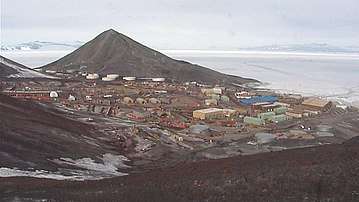McMurdo Station
McMurdo Station is on an Antarctic Island called Ross Island. It is by far the most populous station in summer and something of a transportation hub for members of the scientific community on the southern continent, who sometimes refer to it, tongue-in-cheek, as a "city". While the station is staffed in the winter, too, there are way fewer people, less buzz and nobody not here on scientific or government business would be caught dead in McMurdo in the Antarctic winter.

Understand
| McMurdo Station | ||||||||||||||||||||||||||||||||||||||||||||||||||||||||||||
|---|---|---|---|---|---|---|---|---|---|---|---|---|---|---|---|---|---|---|---|---|---|---|---|---|---|---|---|---|---|---|---|---|---|---|---|---|---|---|---|---|---|---|---|---|---|---|---|---|---|---|---|---|---|---|---|---|---|---|---|---|
| Climate chart (explanation) | ||||||||||||||||||||||||||||||||||||||||||||||||||||||||||||
| ||||||||||||||||||||||||||||||||||||||||||||||||||||||||||||
| ||||||||||||||||||||||||||||||||||||||||||||||||||||||||||||
New Zealand claims a sector of Antarctica called the Ross Dependency, which includes Ross Island, home to McMurdo Station and Scott Base as well as three historic wooden huts (at Hut Point, Cape Evans and Cape Royds as well as the stone hut at Cape Crozier). Claims such as this one are held in abeyance under the terms of the Antarctic Treaty, but official Ross Dependency stamps are still issued and sold at Scott Base and can be used as valid postage back to the rest of the world. This station is also important for access to the South Pole and the American activities in the Antarctic, especially since the USA do not officially claim any part of the continent, but (together with the then USSR) explicitly reserved the right to future claims at the time of the signing of the Antarctic Treaty.
Get in
By plane
Williams Field is an ice runway that is normally open to ski equipped aircraft during the Antarctic summer months, subject to suitable weather conditions. Flights to the Ice depart from Christchurch International Airport in New Zealand and generally involve an 8 hour flight in a military aircraft's cargo hold, as cargo.
By boat
- 🌍 Winter Quarters Bay. This was the landing site used by Robert Falcon Scott on his successful Discovery Expedition 1901-1904. It is the southernmost harbor in the Southern Ocean. Sadly the activities at McMurdo have severely polluted the water and the low temperatures contribute to the cleanup taking ages. This harbor is served twice yearly by ice-breaker assisted ships bringing in supplies for McMurdo.
Get around
The "city" is quite small and therefore easy to get around. While conditions in the Austral summer are not much harsher than Winter in the Nordic countries, visibility and wind, including the so-called "white-out" (both the ground and the sky look equally white due to snow and ice making any type of orientation and navigation nigh impossible) can be a factor and are increasingly so during the austral winter when it gets dark most of the time.
See and do
- 🌍 Chapel of the Snows. A non denominational Christian church.
- 🌍 Observation Hill. A hill outside the base that gives a good overview of the area in good visibility conditions
- 🌍 Albert P. Crary Science and Engineering Center (Crary Lab).
- 🌍 Discovery Hut. This historic wooden building was built by Robert Scott in 1902. It has remained relatively intact due to the cold climate.
The 2 prominent volcanoes, Mount Erebus and Mount Terror, can be reached from McMurdo station.

- 🌍 Mount Erebus. The southernmost active volcano in the world at 3795 meters. Climbable (when not erupting) in the summer. The mountain was named after its discoverer's ship, which in turn was named after the Greek god Erebus, son of Chaos.
- 🌍 Mount Terror. Mount Terror is a large shield volcano on the eastern side of Ross Island. There are many cinder cones and domes on the flanks of the shield, but the volcano is mostly under snow and ice. It is the second-largest of the four volcanoes which make up Ross Island, but it is largely overshadowed by its neighbor, Mount Erebus, which is 30 km (19 mi) to the west. Mount Terror was named in 1841 by Sir Ross for his second ship, HMS Terror. The captain of Terror was Captain Francis Crozier, who was a close friend of Ross.
Buy
- 🌍 Berg Field Center (Southern side of McMurdo).
Eat and drink
- 🌍 McMurdo Coffee House, Beaker Street. One of the few, at most, restaurant-like businesses on Antarctica.
Sleep
You either should try to get lodging from those at the base or get permission to camp at the base. Otherwise, it's going to be very difficult to stay there overnight, and might be better to camp away from the base each night if possible.
Cope
- The Antarctic Sun. The online publication has been covering cutting edge science for the National Science Foundation since 1997–1998 austral summer, though it can be traced back to the 1950s when the U.S. Navy ran logistics for the USAP.
Nearby
Scott Base
- 🌍 Scott Base, ☎ +64 3 358 0200. This base is "right next door" and thus covered as part of this guide. With a summer population of 85 it is rather dwarfed by "Mactown"
Go next
- West Antarctica is quite close to Ross Island.